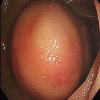Giant ascending colonic diverticulum presenting with intussusception
- PMID: 24278860
- PMCID: PMC3837087
- DOI: 10.3393/ac.2013.29.5.209
Giant ascending colonic diverticulum presenting with intussusception
Abstract
Diverticular disease of the colon is a common disease, and its incidence is increasing gradually. A giant colonic diverticulum (GCD) is a rare entity and is defined as a diverticulum greater than 4 cm in size. It mainly arises from the sigmoid colon, and possible etiology is a ball-valve mechanism permitting progressive enlargement. A plain abdominal X-ray can be helpful to make a diagnosis initially, and a barium enema and abdominal computed tomography may confirm the diagnosis. Surgical intervention is a definite treatment for a GCD. We report a case of an ascending GCD presenting with intussusception in a young adult.
Keywords: Ascending colon; Giant colonic diverticulum; Intussusception; Surgical intervention.
Conflict of interest statement
No potential conflict of interest relevant to this article was reported.
Figures




References
-
- Weilbaecher D, Bolin JA, Hearn D, Ogden W., 2nd Intussusception in adults: review of 160 cases. Am J Surg. 1971;121:531–535. - PubMed
-
- Beddy D, DeBlacam C, Mehigan B. An unusual cause of an acute abdomen: a giant colonic diverticulum. J Gastrointest Surg. 2010;14:2016–2017. - PubMed
-
- Custer TJ, Blevins DV, Vara TM. Giant colonic diverticulum: a rare manifestation of a common disease. J Gastrointest Surg. 1999;3:543–548. - PubMed
-
- Kang JY, Hoare J, Tinto A, Subramanian S, Ellis C, Majeed A, et al. Diverticular disease of the colon--on the rise: a study of hospital admissions in England between 1989/1990 and 1999/2000. Aliment Pharmacol Ther. 2003;17:1189–1195. - PubMed
LinkOut - more resources
Full Text Sources
Other Literature Sources

